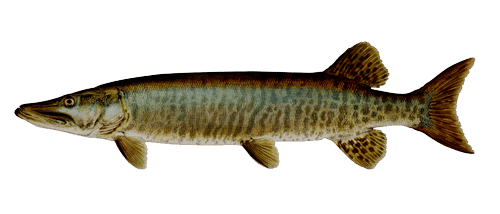
Characteristics
Muskies, formally known as Muskellunge, live in many lakes and rivers. They are very similar to their cousin the Northern Pike. They have around seven pores on each side of the botton of their lower jaw. The Muskie does not have scales on their cheeks. The lobes of their tail are more pointed then those of the Northern pike.
This species in Wisconsin waters usually have dark lateral bars on a light background. Some don’t have any markings or very light on the rear of the fish depending on the water their located in.
Their eating habits are similar to Northern Pike. Younger ones eat vegetation while the older one eats primarily fish. When the water temperature starts getting cooler during the fall season (below 60 degrees) they start eating more to prepare for the winter. As temperatures reach mid 80s they tend to eat the same as they do in fall, however, they are digesting their food faster because they are more active in the summer time.
This fish starts off being smaller than Northern Pike but as they grow older then become larger than Northern Pike ranging over 30 pounds. Fishing regulations help protect they so they can grow very large.
Habitat
They spawn during late spring early summer when water temperatures are 48-59 degrees. A 40 pound female Muskie can spawn up to 200,000 eggs. They spawn two times usually around 14 days after the first spawn. Their eggs don’t cling on to the vegetation, they tend to settle at the bottom of the water. Because the eggs settle at the bottom of the water, they tend to survive more.
Because they spawn later than Northern Pike, Northern Pike have been seen spawning with the Muskies causing an offspring known as a Tiger Muskie.
They live in deep water and move closer to shore to feed. They can feed in 2 feet of water. They feed all times of the day, however, they become active during dusk. After they feed then tend to spend days digesting their food. During the summer time they become more active. When the water temperature gets cooler they tend to increase their feeding to store for the winter. As the temperature gets colder they also become more dormant.
Equipment
Muskies are aggressive game, therefore, heavy weight rods and reels are recommended. 20 – 40 pound test line is used along with heavy weight leaders. Surface baits that create a steady motion and sound is recommended as you do not want to spook a fish. A heavy duty such as a Frable net is a staple in your boat as it will be needed when landing your fish. Musky fish should be kept in the water as you are removing the bait.
Some anglers use protection proof gloves when handling them.
Tips for Fishing
It is recommended that you practice Catch N’ Release as this will help in the protection and existence of these fish.
The DNR is always working on the protection of fish habitat and maintaining a good balance of fish and lake environment in an effort to keep fish well for anglers.

